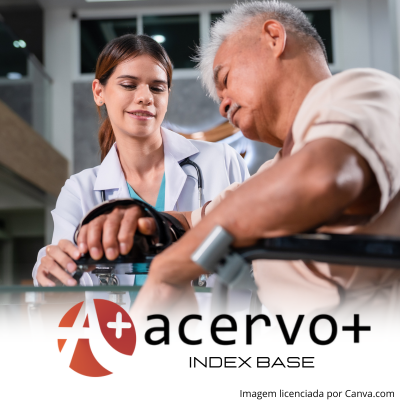Papel do enfermeiro na trombólise de pacientes com Acidente Vascular Cerebral Isquêmico
##plugins.themes.bootstrap3.article.main##
Resumo
Objetivo: Compreender qual o papel do enfermeiro frente a trombólise do paciente vítima de acidente vascular cerebral isquêmico relatados na literatura científica. Métodos: Trata-se de uma revisão integrativa, realizada através da Pubmed. A partir dos descritores consultados no site dos Medical Subject Headings (MeSH): “Thrombolytic Therapy”, “Stroke” e “Nursing”. Como critérios de inclusão, foram considerados artigos publicados nos últimos dez anos, nos idiomas português, inglês e espanhol, de livre acesso e gratuidade, que abordassem o tema. Foram excluídos artigos repetidos e fora do período estipulado, outras revisões, artigos não disponíveis na íntegra e que não são de acesso livre gratuitamente, sendo selecionados 12 artigos. Resultados: Os estudos demonstram que o uso de trombólise intravenosa é frequentemente restrito devido a limitação do tempo em que pode ser usado. Porém, foi evidenciado a importância de os enfermeiros identificarem precocemente os pacientes com Acidente Vascular Cerebral (AVC) verificando possíveis indicações ou contraindicações e a possibilidade do tratamento trombolítico. Considerações finais: Compreendeu-se o papel do enfermeiro frente a trombólise do paciente vítima de AVC isquêmico relatados na literatura, porém percebeu-se que são poucos os artigos que abordam sobre a temática. A maioria das publicações limitam-se a estudar a efetividade do tratamento trombolítico.
##plugins.themes.bootstrap3.article.details##
Copyright © | Todos os direitos reservados.
A revista detém os direitos autorais exclusivos de publicação deste artigo nos termos da lei 9610/98.
Reprodução parcial
É livre o uso de partes do texto, figuras e questionário do artigo, sendo obrigatória a citação dos autores e revista.
Reprodução total
É expressamente proibida, devendo ser autorizada pela revista.
Referências
2. AMORIM DM. Características clínicas e fatores de riscos em pacientes jovens com acidente vascular cerebral. Trabalho de Conclusão do Curso (Bacharelado em Medicina) – Universidade Federal da Bahia, Salvador, 2012; 40.
3. BENSENOR IM,et al. Prevalência de AVC e incapacidade associada no Brasil: pesquisa nacional de saúde. Arq. Neuro-Psiquiatr, 2015; 73(9): 746-750.
4. BRASIL. Resolução CNS nº 466. 2012. Disponível em: https ://conselho.saude.gov.br/resolucoes/2012/R eso466.pdf. Acessado em: 20 de janeiro de 2024.
5. DALPIAN APC e GRAVEMTQ, et al. Avaliação da percepção corporal em pacientes pós-acidente vascular cerebral. Rev. Neurocienc, 2013; 21(3): 377-382.
6. FRANÇA RM e FONTES VLF, et al. O idoso com acidente vascular cerebral (AVC) isquêmico agudo: vivenciando o cuidado. Revista Brasileira de Ciências do Envelhecimento Humano, 2004; 1(2): 22-29.
7. HACKE W, et al. Thrombolysis with Alteplase 3 to 4.5 hours after Acute Ischemic Stroke. N Engl J Med, 2008; 359(13): 1317-29.
8. HASNAIN MG, et al. Can a multicomponentmultidisciplinaryimplementationpackagechangephysicians' and nurses' perceptions and practices regarding thrombolysis for acute ischemic stroke? Anexploratory analysis of a cluster-randomized trial. Implement Sci, 2019; 14(1): 98.
9. HUNG L e HU Y, et al. Exploring the impact of intravenous thrombolysis on length of stay for acutei schemic stroke: a retrospectivec ohort study. BMC Health Services Research, 2015; 15: 404.
10. JAUCH EC, et al. Guidelines for the early management of patients with acute ischemic stroke: a guideline for healthcare professionals from the American Heart Association/ American Stroke Association. Stroke, 2013; 44(3): 870-947.
11. JEON S, et al. Multidisciplinary Approach to Decrease In-Hospital Delay for StrokeThrombolysis. J Stroke, 2017; 19(2): 196-204.
12. LAVADOS PM, et al. Strokeepidemiology, prevention, and management strategiesat a regional level: Latin America and the Caribbean. Lancet Neurol, 2007; 6(4): 362–72.
13. LEVI CR, et al. Cluster‐Randomized Trial of Thrombolysis Implementation Support in Metropolitan and Regional Australian Stroke Centers: Lessons for Individual and Systems Behavior Change. J Am Heart Assoc. 2020; 9(3): 12732.
14. LIU Z, et al. Effects of Nursing Quality Improvement on Thrombolytic Therapy for Acute Ischemic Stroke. Front Neurol. 2019; 29(9): 1025.
15. OLIVEIRA DS. Análise do perfil epidemiológico de pacientes com acidente vascular encefálico atendidos na clínica escola de saúde do UNIFOR-MG. Trabalho de Conclusão de Curso (Bacharelado em Fisioterapia) – Centro Universitário de Formiga, Formiga, 2013; 60.
16. ONG, C, et al. Out come of stroke patients receiving different doses of recombinanttis sueplasminogen activator. Drug Des Devel Ther., 2017; 11: 1159-1566.
17. SÁBPD e GRAVE MTQ, et al. Perfil de pacientes internados por acidente vascular cerebral em hospital do Vale do Taquari - RS. Rev. Neurocienc, 2014; 22(3): 381-387.
18. SAPOSNIK G, et al. Strokeoutcome in those over 80: a multicenter cohort study across Canada. Stroke, 2008; 39(8): 2310-7.
19. SCHMIDT A, et al. AcuteIschemicStroke (AIS) patient management in French stroke units and impact estimation of thrombolysis on care path ways and associated costs. Cere brovasc Dis, 2015; 39(2): 94-101.
20. SBIBAE. SOCIEDADE BENEFICENTE ISRAELITA BRASILEIRA ALBERT EINSTEIN. Diretrizes assistenciais acidente vascular cerebral. 2010. Disponível em: http ://medicalsuite.einstein.br/diretrizes/ neurologia/AVC.pdf. Acessado em: 20 de janeiro de 2025.
21. SOUZA MP e OLIVEIRA IRS. Enfermagem na assistência ao paciente com acidente vascular cerebral em ambiente intra-hospitalar. Monografia (Especialização em Urgência e Emergência) – Faculdade Redentor, Três Rios, 2012; 180.
22. SOUZA MT, et al. Revisão Integrativa: o que é e como fazer. Einstein, 2010; 8(1): 102-106.
23. SUN Z, et al. Effect of Comprehensive Nursing Intervention on the Effect of CT-Guided Intravenous Thrombolysis in Acute Cerebral Infarction. J Healthc Eng, 2022: 6959416.
24. TEXEIRA RA e SILVA LDD, et al. Tratamento trombolítico no Acidente Vascular Cerebral Isquêmico. Revista Neurociências, 2004, 12(1): 1-13.
25. TSENG Y, et al. Risk Factors Associated with Outcomes of Recombinant Tissue Plasminogen Activator Therapy in Patients with Acute Ischemic Stroke. Int J Environ Res Public Health, 2020; 17(2): 618.
26. VENTURELLI PM, et al. Impact of Evidence‐Based Stroke Care on Patient Outcomes: A Multilevel Analysis of an International Study. J Am Heart Assoc. 2019; 8(13): 12640.
27. YIN C, et al. Effect of standardized nursing cooperation on intravenousthrombolysis with recombinantt issue plasminogen activator in acute ischemic stroke. Am J Transl Res. 2021; 13(10): 11925-11931.
28. YOU S, et al. Efficacy and safety of intravenous recombinantt issue plasminogen activator in mildischaemic stroke: a meta-analysis. Stroke Vasc Neurol. 2018; 3(1): 22-27.

